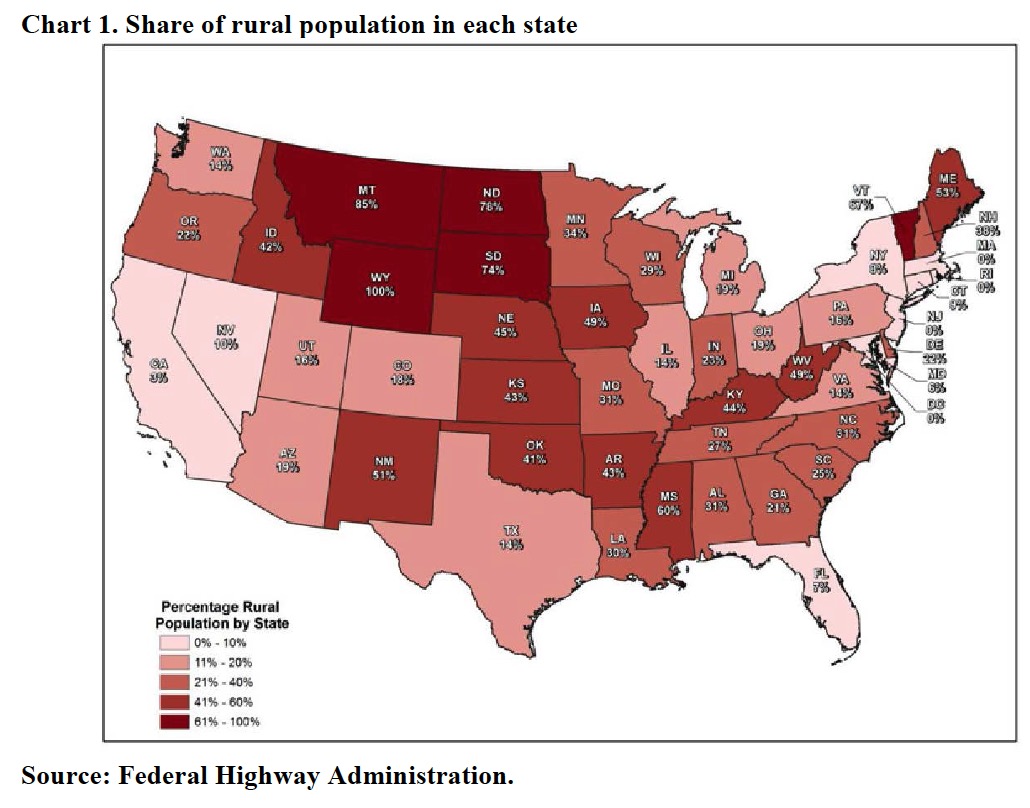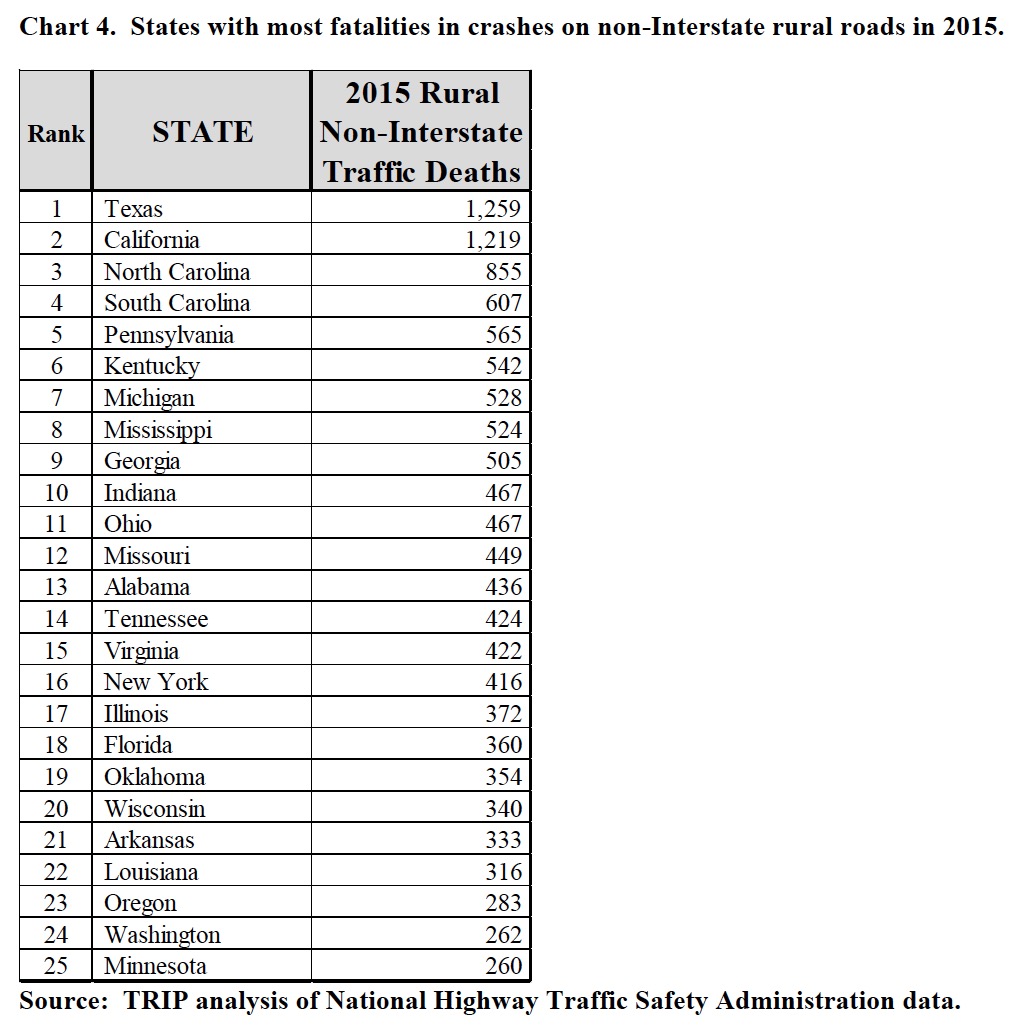TRIP
Executive Summary
America’s rural heartland plays a vital role as home to a significant share of the nation’s population, many of its natural resources, and popular tourist destinations. It is also the primary source of the energy, food and fiber that supports America’s economy and way of life. The strength of the nation’s rural economy is heavily reliant on the quality of its transportation system, particularly the roads and highways that link rural America with the rest of the U.S. and to markets in other countries. The quality and connectivity of America’s rural transportation system supports the economy of the entire nation and quality of life for the approximately 60 million Americans living in rural areas.
 Good transportation is essential in rural areas to provide access to jobs, to facilitate the movement of goods and people, to access opportunities for health care and educational skills, and to provide links to other social services. Transportation supports businesses and is a critical factor in a company’s decision to locate new business operations. For communities that rely on tourism and natural amenities to help support their economy, transportation is the key link between visitors and destinations.
Good transportation is essential in rural areas to provide access to jobs, to facilitate the movement of goods and people, to access opportunities for health care and educational skills, and to provide links to other social services. Transportation supports businesses and is a critical factor in a company’s decision to locate new business operations. For communities that rely on tourism and natural amenities to help support their economy, transportation is the key link between visitors and destinations.
Roads, highways, rails and bridges in the nation’s heartland face a number of significant challenges: they lack adequate capacity, they fail to provide needed levels of connectivity to many communities, and they cannot adequately support growing freight travel in many corridors. Rural roads and bridges have significant deficiencies and deterioration, they lack many desirable safety features, and they experience fatal traffic crashes at a rate far higher than all other roads and highways. This report looks at the condition, use and safety of the nation’s rural transportation system, particularly its roads, highways and bridges, and identifies needed improvements.
Rural areas in this report are based on the U.S. Census Bureau definition, which defines rural areas as regions outside of urban areas with a population of 2,500 or more. Road, bridge and safety data in this report is based on the Federal Highway Administration (FHWA) definition for rural areas, which allows states to use the U.S. Census Bureau definition to identify rural routes or to define rural areas as regions outside of urban areas with a population of 5,000 or more. The following are the key findings of the report.
An aging and increasingly diverse rural America plays a vital role as home to a significant share of the nation’s population, natural resources and tourist destinations. It is also the primary source of the energy, food and fiber that drive the U.S. economy. Rural Americans are more reliant on their transportation system than their urban counterparts.
- While there are many ways to define rural, the U.S. Census Bureau defines rural areas as regions outside of urban areas with a population of 2,500 or more.
- According to the U.S. Census Bureau definition, 19 percent of the nation’s residents live in rural areas – approximately 60 million of the nation’s 316 million people in 2015.
- The nation’s rural areas account for 97 percent of America’s land area and are home to the vast majority of the nation’s 2.2 million farms.
- America’s rural population increased gradually each year from 1976 to 2010, rising between 0.1 and 1.5 percent each year. From 2010 to 2014, the nation’s rural population declined slightly by 0.3 percent before stabilizing in 2015 as rural areas continued to recover from the Great Recession.
- While overall rural populations declined slightly between 2010 and 2014, population did increase in some rural areas during that time. This population increase occurred primarily in rural counties that have been impacted by increased energy extraction, particularly in the Northern Great Plains as well as portions of Arkansas, Louisiana, Pennsylvania and Texas.
- Unemployment in rural areas increased from 5.2 percent in 2007 to 9.9 percent in 2010, before decreasing to 5.7 percent in 2015.
- America’s rural economy is far more reliant on goods production, which includes farming, forestry, fishing, mining and energy extraction, and manufacturing, than is the nation’s urban economy.
- Many of the transportation challenges facing rural America are similar to those in urbanized areas. However, rural residents tend to be more heavily reliant on their limited transportation network – primarily rural roads and highways – than their counterparts in more urban areas. Residents of rural areas often must travel longer distances to access education, employment, retail locations, social opportunities and health services.
- The rural U.S. population is aging more rapidly than the nation as a whole. The share of older adults in rural areas is disproportionate, with 17.2 percent of those living in rural areas over age 65, while 12.8 percent of residents in urban areas and 13 percent of the nation’s total population are over 65.
- The movement of retiring baby boomers to rural America is likely to continue in the future as aging Americans seek out communities that offer affordable housing, small-town quality of life and desirable natural amenities, while often located within a short drive of larger metropolitan areas.
- Rural areas are growing increasingly more diverse. Although racial and ethnic minorities make up only 21 percent of the rural population, minorities accounted for nearly 83 percent of rural population growth between 2000 and 2010.
- The amount of rural tourism in a region is tied partly to the level of highway access. Eighty-six percent of trips taken by Americans to visit rural areas are for leisure purposes.
- Popular tourism activities in rural America include hiking, golfing, biking, hunting, fishing and water sports. Rural areas are also home to beaches, national and state parks, wineries, orchards and other national amenities.
 The quality of life in America’s small communities and rural areas and the health of the nation’s rural economy is highly reliant on the quality of the nation’s transportation system, particularly its roads, highways and bridges. America’s rural transportation network provides the first and last link in the supply chain from farm to market while supporting the tourism industry and enabling the production of energy, food and fiber.
The quality of life in America’s small communities and rural areas and the health of the nation’s rural economy is highly reliant on the quality of the nation’s transportation system, particularly its roads, highways and bridges. America’s rural transportation network provides the first and last link in the supply chain from farm to market while supporting the tourism industry and enabling the production of energy, food and fiber.
- Freight mobility and efficiency is fundamental to rural economic vitality and prosperity. Economic growth and stability in rural areas is heavily reliant on the ability to move raw materials into, or the value-added products out of, these areas.
- Agriculture, food, and related industries, including food and beverage manufacturing, apparel manufacturing and food and beverage stores and establishments — which rely on agricultural inputs — contributed $992 billion to the U.S. GDP in 2015 – 5.5 percent of overall U.S. GDP.
- Despite record yields, lower crop prices have resulted in total U.S. crop receipts declining from a record $232 billion in 2012 to a forecast $187 billion in 2017.
- While farming accounts for just six percent of all jobs in rural America, for every person employed in farming there are seven more jobs in agribusiness, including wholesale and retail trade, processing, marketing, production, and distribution.
- Employment in goods production, which includes farming, forestry, fishing, mining and energy extraction, accounts for 11 percent of earnings in the nation’s rural economy versus two percent in the urban economy.
- Manufacturing jobs account for 15 percent of earnings in the nation’s rural economy versus nine percent in the urban economy.
- A United States Department of Agriculture (USDA) report found that “an effective transportation system supports rural economies, reducing the prices farmers pay for inputs such as seeds and fertilizers, raising the value of their crops and greatly increasing market access.”
- Trucks provide the majority of transportation for agricultural products, accounting for 46 percent of total ton miles of travel compared to 36 percent by rail and 12 percent by barge.
- Trucks account for the vast majority of transportation for perishable agricultural items, carrying 91 percent of ton miles of all fruit, vegetables, livestock, meat, poultry and dairy products in the U.S.
- The Council of State Governments recently found that “rural highways provide many benefits to the nation’s transportation system, including serving as a bridge to other states, supporting the agriculture and energy industries, connecting economically challenged citizens in remote locations to employers, enabling the movement of people and freight and providing access to America’s tourist attractions.”
- The rapid expansion of the energy extraction industry, particularly in the Great Plains states, has consumed rail capacity that had previously been used to move agricultural goods. As a result, the agricultural goods that had been shipped by rail are now being moved via alternate transportation means, placing additional stress on the rural highway system and increasing costs to farmers and consumers.
- Transportation is becoming an even more critical segment of the food distribution network. While food demand is concentrated mostly in urban areas, food distribution is the most dispersed segment of the economy.
- A highly competitive and efficient transportation system can lead to lower food costs for U.S. consumers and higher market prices for producers due to lower shipping costs, smaller margins and more competitive export prices.
- A report by the Pacific Economic Cooperation Council recommends that governments improve the quality of their transportation systems serving the movement of goods from rural to urban regions as a strategy to lower food costs and increase economic prosperity.
- A report on agricultural transportation by the USDA found it likely that market changes and shifts in consumer preferences would further increase the reliance on trucking to move U.S. agricultural products.
The condition and quality of the nation’s highway system plays a critical role in providing access to America’s many tourist destinations, particularly its scenic parks and recreational areas, which are mostly located in rural areas.
- In 2016, travel and tourism related spending in the U.S. contributed $1.5 trillion to U.S. Gross Domestic Product. Tourism related jobs employed 5.5 million Americans in 2016.
- America’s national parks, which are largely located in rural areas, received a record 331 million visitors in 2016, many in personal vehicles.
Download full version (PDF): Challenges and Opportunities in America’s Heartland
About TRIP
www.tripnet.org
Founded in 1971, TRIP is a private nonprofit organization that researches, evaluates and distributes economic and technical data on surface transportation issues. TRIP promotes transportation policies that help relieve traffic congestion and its impact on air quality, improve road and bridge conditions, make surface travel safer, and enhance economic productivity. TRIP is sponsored by insurance companies, equipment manufacturers, distributors and suppliers, businesses involved in highway and transit engineering and construction, labor unions, and organizations concerned with an efficient and safe surface transportation network that promotes economic development and quality of life.






 RSS Feed
RSS Feed